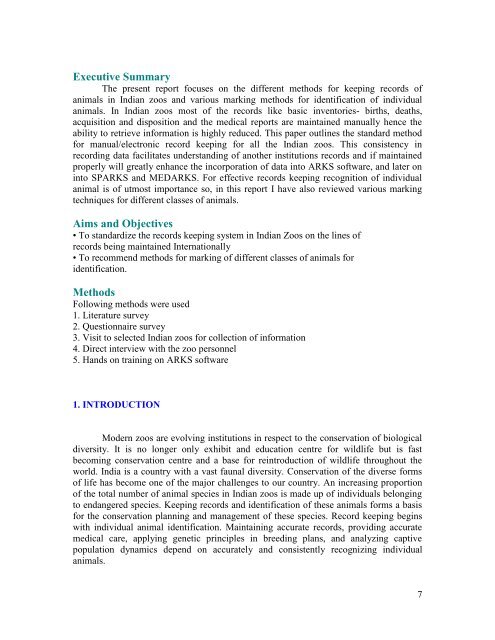standardization of records keeping in indian zoos - Central Zoo ...
standardization of records keeping in indian zoos - Central Zoo ...
standardization of records keeping in indian zoos - Central Zoo ...
You also want an ePaper? Increase the reach of your titles
YUMPU automatically turns print PDFs into web optimized ePapers that Google loves.
Executive Summary<br />
The present report focuses on the different methods for <strong>keep<strong>in</strong>g</strong> <strong>records</strong> <strong>of</strong><br />
animals <strong>in</strong> Indian <strong>zoos</strong> and various mark<strong>in</strong>g methods for identification <strong>of</strong> <strong>in</strong>dividual<br />
animals. In Indian <strong>zoos</strong> most <strong>of</strong> the <strong>records</strong> like basic <strong>in</strong>ventories- births, deaths,<br />
acquisition and disposition and the medical reports are ma<strong>in</strong>ta<strong>in</strong>ed manually hence the<br />
ability to retrieve <strong>in</strong>formation is highly reduced. This paper outl<strong>in</strong>es the standard method<br />
for manual/electronic record <strong>keep<strong>in</strong>g</strong> for all the Indian <strong>zoos</strong>. This consistency <strong>in</strong><br />
record<strong>in</strong>g data facilitates understand<strong>in</strong>g <strong>of</strong> another <strong>in</strong>stitutions <strong>records</strong> and if ma<strong>in</strong>ta<strong>in</strong>ed<br />
properly will greatly enhance the <strong>in</strong>corporation <strong>of</strong> data <strong>in</strong>to ARKS s<strong>of</strong>tware, and later on<br />
<strong>in</strong>to SPARKS and MEDARKS. For effective <strong>records</strong> <strong>keep<strong>in</strong>g</strong> recognition <strong>of</strong> <strong>in</strong>dividual<br />
animal is <strong>of</strong> utmost importance so, <strong>in</strong> this report I have also reviewed various mark<strong>in</strong>g<br />
techniques for different classes <strong>of</strong> animals.<br />
Aims and Objectives<br />
• To standardize the <strong>records</strong> <strong>keep<strong>in</strong>g</strong> system <strong>in</strong> Indian <strong>Zoo</strong>s on the l<strong>in</strong>es <strong>of</strong><br />
<strong>records</strong> be<strong>in</strong>g ma<strong>in</strong>ta<strong>in</strong>ed Internationally<br />
• To recommend methods for mark<strong>in</strong>g <strong>of</strong> different classes <strong>of</strong> animals for<br />
identification.<br />
Methods<br />
Follow<strong>in</strong>g methods were used<br />
1. Literature survey<br />
2. Questionnaire survey<br />
3. Visit to selected Indian <strong>zoos</strong> for collection <strong>of</strong> <strong>in</strong>formation<br />
4. Direct <strong>in</strong>terview with the zoo personnel<br />
5. Hands on tra<strong>in</strong><strong>in</strong>g on ARKS s<strong>of</strong>tware<br />
1. INTRODUCTION<br />
Modern <strong>zoos</strong> are evolv<strong>in</strong>g <strong>in</strong>stitutions <strong>in</strong> respect to the conservation <strong>of</strong> biological<br />
diversity. It is no longer only exhibit and education centre for wildlife but is fast<br />
becom<strong>in</strong>g conservation centre and a base for re<strong>in</strong>troduction <strong>of</strong> wildlife throughout the<br />
world. India is a country with a vast faunal diversity. Conservation <strong>of</strong> the diverse forms<br />
<strong>of</strong> life has become one <strong>of</strong> the major challenges to our country. An <strong>in</strong>creas<strong>in</strong>g proportion<br />
<strong>of</strong> the total number <strong>of</strong> animal species <strong>in</strong> Indian <strong>zoos</strong> is made up <strong>of</strong> <strong>in</strong>dividuals belong<strong>in</strong>g<br />
to endangered species. Keep<strong>in</strong>g <strong>records</strong> and identification <strong>of</strong> these animals forms a basis<br />
for the conservation plann<strong>in</strong>g and management <strong>of</strong> these species. Record <strong>keep<strong>in</strong>g</strong> beg<strong>in</strong>s<br />
with <strong>in</strong>dividual animal identification. Ma<strong>in</strong>ta<strong>in</strong><strong>in</strong>g accurate <strong>records</strong>, provid<strong>in</strong>g accurate<br />
medical care, apply<strong>in</strong>g genetic pr<strong>in</strong>ciples <strong>in</strong> breed<strong>in</strong>g plans, and analyz<strong>in</strong>g captive<br />
population dynamics depend on accurately and consistently recogniz<strong>in</strong>g <strong>in</strong>dividual<br />
animals.<br />
7
















